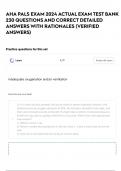Exam (elaborations)
AHA PALS EXAM 2024 ACTUAL EXAM TEST BANK 230 QUESTIONS AND CORRECT DETAILED ANSWERS WITH RATIONALES (VERIFIED ANSWERS)
- Course
- Institution
AHA PALS EXAM 2024 ACTUAL EXAM TEST BANK 230 QUESTIONS AND CORRECT DETAILED ANSWERS WITH RATIONALES (VERIFIED ANSWERS)
[Show more]



